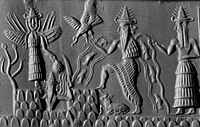Anu
Anu[edit]
Anu (also known as An) is the ancient Mesopotamian god of the sky and the supreme deity. He was considered the divine personification of the sky and the ancestor of all deities. Anu, along with his sons Enlil and Enki, formed the highest divine triad, representing the three bands of constellations in the sky. By the time written records began, Anu's worship had mostly been replaced by that of his son Enlil, but he remained the symbol of ultimate authority.
Worship[edit]

Anu was revered as the personification of the sky and the supreme deity. He was identified with the equatorial sky and constellations like Virgo. Together with Enlil and Enki, he formed a divine triad, with Anu representing a transcendental obscurity, Enlil the transcendent, and Enki the immanent aspect of the divine.
Anu's primary cult center was the Eanna temple in Uruk, initially dedicated to him but later to Inanna. Anu was seen as the source of all legitimate power and the bestower of kingship. Inscriptions from Sargon of Akkad proclaim Anu as the source of his authority. Although Anu was rarely worshipped directly, his role as the ancestor of the Anunnaki, the major deities, was significant.
Anu's original name in Sumerian is "An," and he was also identified with the Semitic god Ilu or El. Over time, his cult waned, and he was superseded by Enlil and later by Marduk. However, references to Anu's power were preserved in archaic phrases.
Mythology[edit]
Sumerian[edit]
In Sumerian mythology, Anu is the father of the gods and a creator deity. In the creation myth, Nammu, the primeval sea, gives birth to An (the sky) and Ki (the earth). An and Ki mate, leading to the birth of Enlil, who separates An from Ki.
In the myth "Inanna and Ebih," Anu's granddaughter Inanna seeks permission to destroy Mount Ebih, but Anu warns her against it. In another myth, "Inanna Takes Command of Heaven," Inanna claims the Eanna temple in Uruk, and Anu concedes it to her.
Akkadian[edit]

In the Epic of Gilgamesh, Ishtar, Anu's daughter, tries to seduce Gilgamesh. When Gilgamesh rejects her, Ishtar asks Anu for the Bull of Heaven to attack Gilgamesh. Anu grants her request, leading to the Bull's defeat by Gilgamesh and Enkidu.
In the myth of Adapa, Anu summons the mortal hero Adapa for breaking the wing of the south wind. Anu orders Adapa to be given the food and water of immortality, but Adapa, warned by Enki, refuses and returns to earth.
Later Influence[edit]
Anu is analogous to the Greek god Uranus and the Canaanite god Shamem. In later times, Anu's attributes were ascribed to El, the ruler of the Canaanite gods. The story of Adapa has parallels with the biblical story of Adam and Eve.
References[edit]
Bibliography[edit]
- Bertman, Stephen. Handbook to Life in Ancient Mesopotamia, Facts On File, 2003, ISBN 0-8160-4346-9 Search this book on
 ..
.. - Black, Jeremy; Green, Anthony (1992), Gods, Demons and Symbols of Ancient Mesopotamia: An Illustrated Dictionary, The British Museum Press, ISBN 0-7141-1705-6
- Dalley, Stephanie (1989), Myths from Mesopotamia: Creation, the Flood, Gilgamesh, and Others, Oxford, England: Oxford University Press, ISBN 0-19-283589-0
- Mark, Joshua (20 January 2017), "Anu", Ancient History Encyclopedia, Ancient History Encyclopedia
- Stephens, Kathryn (2013), "An/Anu (god): Mesopotamian sky-god, one of the supreme deities; known as An in Sumerian and Anu in Akkadian", Ancient Mesopotamian Gods and Goddesses, Open Richly Annotated Cuneiform Corpus, UK Higher Education Academy
This article "Anu" is from Wikipedia. The list of its authors can be seen in its historical. Articles copied from Draft Namespace on Wikipedia could be seen on the Draft Namespace of Wikipedia and not main one.
The article on Wikipedia is licensed under the CC BY-SA 3.0 license, and may have been edited to reflect more or different information.

